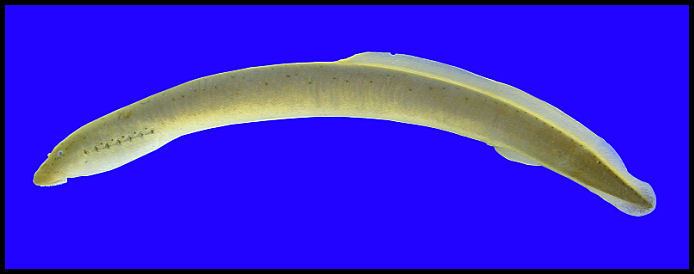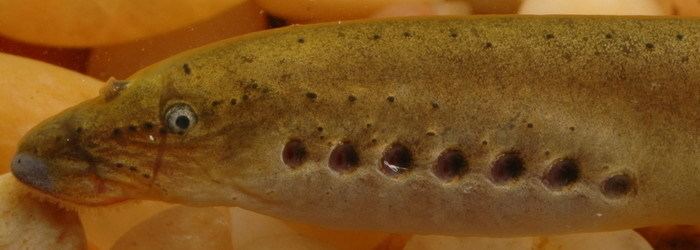Phylum Chordata Rank Species | Family Petromyzontidae Scientific name Ichthyomyzon gagei Higher classification Ichthyomyzon Order Lamprey | |
 | ||
Similar Ichthyomyzon, Lamprey, Northern brook lamprey, Chestnut lamprey, Ohio lamprey | ||
Southern brook lamprey 1
The southern brook lamprey (Ichthyomyzon gagei) is a lamprey found in the Southern United States including Arkansas, Louisiana, Mississippi, Alabama, and Georgia. It is a jawless fish with a sucking mouth on one end of it (like a leech.) It can appear to be a small eel, since it is rarely longer than 1 feet in length.
Contents
- Southern brook lamprey 1
- Southern brook lampreys
- Geographic Distribution
- Ecology
- Life History
- Current Management
- References

The southern brook lamprey is a non-parasitic fish native to distinctive aquatic habitats in North America which must be protected in order for this species to continue to thrive. This paper incorporates strategies aimed at protecting the distinct microhabitats of I. gagei from human interference, including pollution and habitat degradation. I. gagei inhabits a geographic area stretching from southern Mississippi, Georgia, and Florida along the Gulf Coast west to Oklahoma and Texas and have been reported as far north as Minnesota and Wisconsin. I. gagei inhabits specific types of microhabitats at different morphological phases of its life cycle which consists of two distinct stages. During the larval stage, I. gagei are most often found burrowed into fine sandy creek substrate, but are also occasionally found burrowed among dense clusters of leaves or other aquatic vegetation. Ammocoetes, or larval stage lampreys, feed on diatoms and other organic particles collected mainly off the substrate. I. gagei larvae typically undergo metamorphosis after 3 years; however, some ammocoetes stay in the larval stage for an additional year. Following metamorphosis from the larval stage, the adult stage is reached. During this phase, I. gagei does not eat; rather, it obtains energy from stored fat reserves collected as ammocoetes and also migrates from slow moving streams to faster moving water with slightly larger pebbles as opposed to fine sandy substrate. This fasting behavior continues until spawning during which adult lampreys come together from late April to early May and spawn in habitats consisting of small, shallow ripples with 17-21°C water. Although I. gagei populations have been found to be generally stable, due to the strict habitat requirements during each phase of its life cycle, the quality of each of these habitats must be preserved in order to ensure that the specific niche filled by the southern brook lamprey is protected.

Southern brook lampreys
Geographic Distribution

The southern brook lamprey occurs in slow moving rivers and streams from Florida to southern Mississippi, Georgia, and Arkansas along the Gulf Coast west to Oklahoma and Texas. The southern brook lamprey ranges as far north as Minnesota and Wisconsin. Specifically, southern brook lamprey have been reported to occur in the Chattahoochee river system and the Conecuh river system in Alabama, the Sabine river system in Texas and Louisiana, the Illinois river system in Oklahoma, and the Neches river system in Texas. The southern brook lamprey was thought to be restricted to the southern United States; however, Becker observed southern brook lamprey in Wisconsin in 1983. The southern brook lamprey has also been reported to occur as far north as the Spruce river and the Tamarac river in Wisconsin and Minnesota. Unpublished findings have also shown that the southern brook lamprey inhabits tributaries of Choctawhatchee Bay and the Ochlockonnee river system in Florida, the Chattahoochee river system in Georgia, and the Trinity and San Jacinto river systems in Texas.
Ecology

The diet of the southern brook lamprey changes as it undergoes metamorphosis during its life cycle from one phase to the next. The diet of larval southern brook lamprey consists mainly of organic detritus. Studies that focused on closely related lamprey species (I. fossor) found that the stomach contents of larval lampreys contained 97.9% organic detritus, 2.12% algae, and 0.09% bacteria. After metamorphosis into the adult phase, southern brook lampreys do not feed but rely on stored fat reserves accumulated during the larval stage for energy and nutrients. Studies have found that the digestive tract of the southern brook lamprey actually shrinks and becomes functionally useless as larval lampreys enter the adult stage. The southern brook lamprey encounters a wide range of predators in its natural habitat. The eggs of adult lampreys are preyed on by various species of fish and crayfish. Southern brook lampreys in the larval stage serve as prey for a wide range of fish and bird species. Adult forms of the Southern brook lamprey are preyed upon by larger fish species such as the Northern pike (E. lucius), perch species, the European chub (S. cephalus), and the mudpuppy (N. maculosus). The southern brook lamprey shares similar habitats and resources with many species of shiners (Notropis), the longnose dace (Rhinichthys cataractae), Johnny darters (Etheostoma nigrum), and mottled sculpins (Cottus bairdi).
Life History
The southern brook lamprey's life cycle consists of two main stages: larval and adult. During the larval stage, the southern brook lamprey inhabits a distinct micro habitat involving relatively slow moving water and a sandy substrate. The consistency of the substrate is vitally important to the Southern brook lamprey because during the larval stage, the southern brook lamprey burrows into the substrate using its oral disk as an anchor. The southern brook lamprey secretes mucus from its body to form a tube leading to the entrance of the burrow and to provide support for the burrow. The formation of this larval burrow relies on the composition and size of the substrate available. The combination of both small and large particles and coarse and fine sand grains allow the southern brook lamprey to construct a suitable burrow that allows enough water to flow through the burrow to ensure proper respiration. The substrate in which larval southern brook lamprey burrow must not contain too many fine silt and clay particles as this would inhibit respiration while too many particles of coarse sand would hinder proper burrow construction. The larval stage is complete after approximately three years. Following the larval stage, the southern brook lamprey undergoes metamorphosis into the adult form. Adult southern brook lamprey are found in crevices and cracks between large rocks in deeper, faster moving water than the habitat occupied during the larval stage. After completing the metamorphosis to adults, southern brook lampreys come together in groups to spawn and, once spawning is complete, the adults die. Spawning usually occurs between April and May and takes place in another distinct microhabitat consisting of shallow riffle areas with rocky substrate with a water temperature falling between 17°C to 21°C. Fecundity of the southern brook lamprey averages between 800 and 2500 oocytes. Human factors have been found to influence the available habitat for spawning southern brook lampreys. Southern brook lampreys have been recorded using shallow areas under bridges as spawning grounds possibly to help conceal spawning aggregations from visual predators.
Current Management
The southern brook lamprey is currently listed as a species of “least concern” in the United States by CN Red List. The southern brook lamprey has also not been given any status regarding endangerment by the US Federal List or CITES. Currently there are no conservation plans in action specific to the southern brook lamprey nor laws or protected waterways aimed at conservation. No evidence of biological factors has been found that would contribute to a decline in the abundance or the range of the southern brook lamprey, in fact, the biggest threat to the southern brook lamprey and closely related species is human induced alteration of suitable microhabitats. In order to preserve these specific types of microhabitats used by the southern brook lamprey during each phase of the life cycle, habitat preservation and rehabilitation of affected microhabitats are essential. Microhabitats used by the southern brook lamprey during all life stages must have a certain water temperature, substrate composition, and water quality in order for the southern brook lamprey to successfully inhabit and spawn in these areas.
